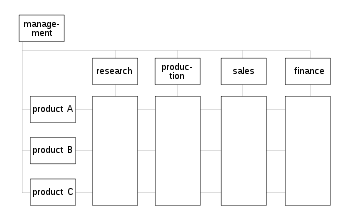
Matrix management
Encyclopedia

Management
Management in all business and organizational activities is the act of getting people together to accomplish desired goals and objectives using available resources efficiently and effectively...
in which people with similar skills are pooled for work assignments. For example, all engineer
Engineer
An engineer is a professional practitioner of engineering, concerned with applying scientific knowledge, mathematics and ingenuity to develop solutions for technical problems. Engineers design materials, structures, machines and systems while considering the limitations imposed by practicality,...
s may be in one engineering department and report to an engineering manager, but these same engineers may be assigned to different projects and report to a different engineering manager or a project manager while working on that project. Therefore, each engineer may have to work under several managers to get their job done.
The matrix
Some organizations fall somewhere between the fully functionalFunctional management
Functional management is the most common type of organizational management. The organization is grouped by areas of specialty within different functional areas . Some refer to a functional area as a "silo." Communication generally occurs within a single department...
and pure matrix. These organizations are defined in A Guide to the Project Management Body of Knowledge (PMBOK) 4th Edition as composite. For example, even a fundamentally functional or matrix organization may create a special project team to handle a critical project.
Whereas project-centered organizations (like those in engineering, construction or the aerospace industries) have structures built around project teams as their functional units, matrix organizations follow the traditional structures, with some adjustments to their hierarchy to support project units.
Controversy
Proponents of matrix management suggest that there are two advantages to matrix management. First, it allows team members to share information more readily across task boundaries. Second, it allows for specialization that can increase depth of knowledge and allow professional development and career progression to be managed.The disadvantage of matrix management is that employees can become confused due to conflicting loyalties. The belief is that a properly managed cooperative environment can neutralize these disadvantages.
Opponents of matrix management believe that it is an outdated method to organize a company.
One disadvantage of matrix management is that it doubles the number of managers when compared to line management
Line management
Line management is a business term to describe the administration of activities that contribute directly to the output of products or services. In a corporate hierarchy a "line manager" holds authority in a vertical 'line' , and/or over a particular product line...
, and as the time to reach a decision increases with the number of managers the result may be an increase in management related overhead expenses.
Advantages and disadvantages
The advantages of a matrix include:- Individuals can be chosen according to the needs of the project.
- The use of a project team which is dynamic and able to view problems in a different way as specialists have been brought together in a new environment.
- Project managers are directly responsible for completing the project within a specific deadline and budget.
Whilst the disadvantages include:
- A conflict of loyalty between line managers and project managers over the allocation of resources.
- Projects can be difficult to monitor if teams have a lot of independence.
- Costs can be increased if more managers (i.e. project managers) are created through the use of project teams.
Visual representation
Representing matrix organizations visually has challenged managers ever since the matrix management structure was invented. Most organizations use dotted lines to represent secondary relationships between people, and charting software such as Visio and OrgPlus support this approach. Until recently, Enterprise resource planningEnterprise resource planning
Enterprise resource planning systems integrate internal and external management information across an entire organization, embracing finance/accounting, manufacturing, sales and service, customer relationship management, etc. ERP systems automate this activity with an integrated software application...
(ERP) and Human resource management systems
Human resource management systems
A Human Resource Management System or Human Resource Information System , refers to the systems and processes at the intersection between human resource management and information technology...
(HRMS) software did not support matrix reporting. Late releases of SAP
SAP AG
SAP AG is a German software corporation that makes enterprise software to manage business operations and customer relations. Headquartered in Walldorf, Baden-Württemberg, with regional offices around the world, SAP is the market leader in enterprise application software...
software support matrix reporting, and Oracle
Oracle Corporation
Oracle Corporation is an American multinational computer technology corporation that specializes in developing and marketing hardware systems and enterprise software products – particularly database management systems...
eBusiness Suite can also be customized to store matrix information.
Clarification
Matrix management should not be confused with "tight matrix". Tight matrix, or co-location, refers to locating offices for a project team in the same room, regardless of management structure.Further reading
- Galbraith, J.R. (1971). "Matrix Organization Designs: How to combine functional and project forms". In: Business Horizons, February, 1971, 29-40.
- "A Guide to the Project Management Body of KnowledgeProject Management Body of KnowledgeA Guide to the Project Management Body of Knowledge is a book which presents a set of standard terminology and guidelines for project management. The Fourth Edition was recognized by the American National Standards Institute as an American National Standard...
(PMBOK)", Project Management Institute, ISBN 1-880410-23-0 - R J Shepherd (2007). "Mentoring Soft Boundaries for Management", , MIDAS MDF 2007;2:79-89

